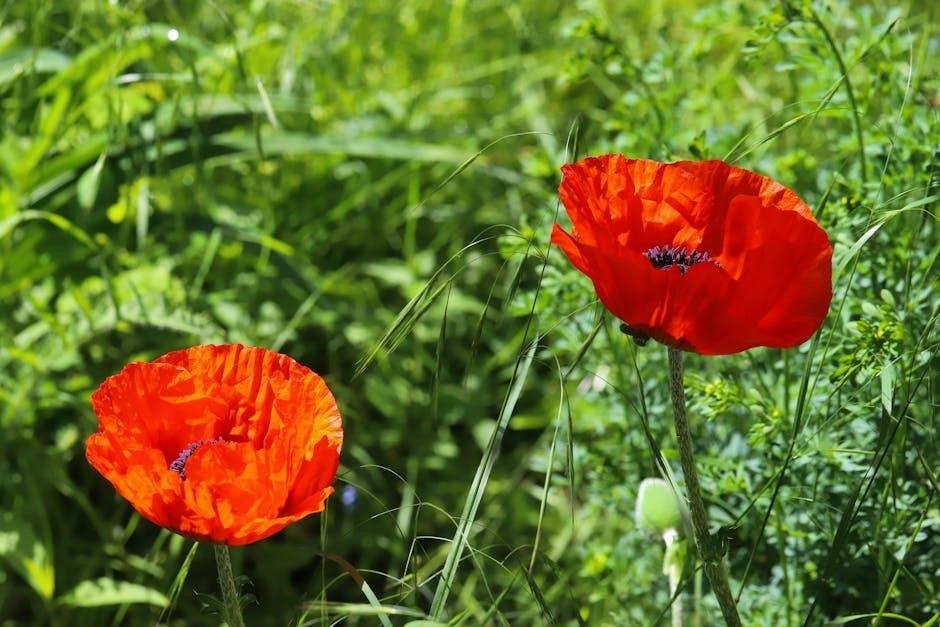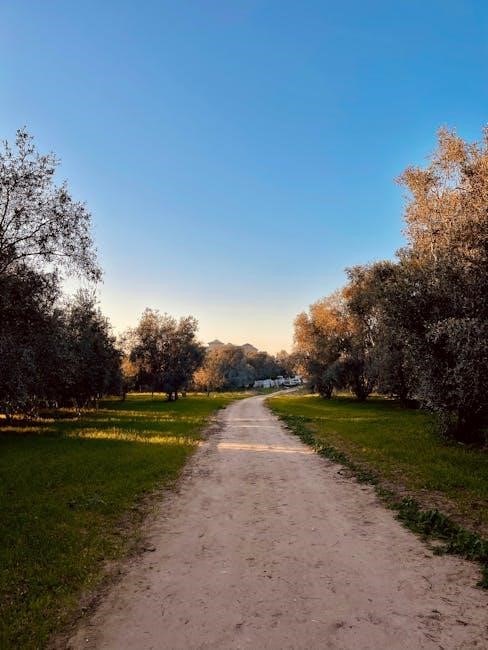Alice Walker’s The Flowers is a poignant short story from her 1973 collection In Love and Trouble: Stories of Black Women. It explores themes of innocence‚ violence‚ and racial injustice through the eyes of a young Black girl‚ Myop‚ whose idyllic world is shattered by a horrifying discovery. The story is a masterful example of Walker’s ability to convey profound truths through sparse‚ evocative prose‚ making it a cornerstone of her literary legacy.
1.1 Overview of the Short Story
The Flowers by Alice Walker is a brief yet powerful tale about a young Black girl named Myop‚ who lives in the rural South. While gathering flowers‚ she discovers a lynched man’s skeleton‚ symbolizing racial violence and shattering her innocence. The story explores themes of loss‚ brutality‚ and racial injustice through her tragic awakening.
1.2 Historical Context and Publication
The Flowers was published in 1973 as part of Alice Walker’s collection In Love and Trouble: Stories of Black Women. Set in the Deep South post-Civil War‚ the story reflects the era’s racial tensions and violence‚ offering a poignant commentary on the experiences of Black women during this time.
1.3 Importance in Alice Walker’s Body of Work
The Flowers stands as a pivotal piece in Alice Walker’s oeuvre‚ showcasing her ability to explore themes of racial injustice and female experience. Its concise yet powerful narrative style influenced her later works‚ solidifying her reputation as a nuanced storyteller and a leading voice in African-American literature.

Plot Summary of “The Flowers”
The story follows Myop‚ a young Black girl‚ as she discovers a lynched man’s skeleton while picking flowers‚ shattering her innocence and revealing racial violence in the rural South.
2.1 The Protagonist: Myop’s Character and Journey
Myop‚ a carefree and innocent ten-year-old Black girl‚ embodies youthful curiosity and joy. Her journey through the woods‚ marked by her fascination with nature‚ takes a devastating turn‚ transforming her from a child into a witness of racial brutality‚ forever altering her perception of the world.
2.2 The Discovery: Symbolism and Impact
Myop’s discovery of the lynched man’s skeleton is a harrowing moment‚ symbolizing the brutal reality of racial violence in the Deep South. The flowers she gathers‚ once representing innocence‚ now contrast starkly with the ugliness of death‚ shattering her naivety and forever changing her worldview.
2.3 The Loss of Innocence: Central Theme
Myop’s discovery of the lynched man’s skeleton symbolizes her abrupt loss of innocence. The vibrant flowers she gathers contrast with the grim reality of racial violence‚ forcing her to confront the harsh truths of her world. This moment irreparably shifts her perception of life‚ marking her transition to adulthood.
Themes in “The Flowers”
The story explores themes of innocence lost‚ racial violence‚ and the harsh realities of life in the Deep South‚ contrasting beauty with brutality through symbolic imagery.
3.1 Coming of Age and Innocence Lost
Myop’s journey symbolizes the abrupt transition from childhood innocence to harsh reality. Her discovery of the skeleton shatters her carefree existence‚ exposing her to racial violence and the brutal truths of the adult world‚ forever altering her worldview and marking her loss of innocence.
3.2 Racism and Violence in the Deep South
The story underscores the pervasive racism and violence in the post-Civil War South‚ where Black lives were devalued. The skeleton Myop discovers embodies the brutal legacy of lynching‚ a practice rooted in racial hatred‚ highlighting the systemic oppression that shaped the lives of Black Americans during this era.
3.4 Nature as a Symbol of Beauty and Brutality
Nature in The Flowers serves as a dual symbol‚ representing both beauty and brutality. The vibrant‚ life-giving flowers contrast starkly with the skeletal remains‚ symbolizing how beauty coexists with violence in the South. This duality mirrors the harsh realities faced by Black communities amidst natural splendor.
Symbolism of Flowers in the Story
The flowers symbolize life and death‚ representing Myop’s innocence and the tragic discovery that shatters it‚ contrasting beauty with brutality in the narrative.
4.1 Flowers as a Representation of Life and Death
The flowers symbolize life through their vibrant beauty and Myop’s innocent gathering‚ yet they also represent death as they contrast with the brutal discovery of a lynched man’s remains‚ highlighting the duality of existence and racial violence.
4.2 Contrasting Beauty with Violence
The flowers symbolize beauty and innocence‚ while their juxtaposition with the lynched man’s skeleton reveals the harsh violence of racial hatred. This contrast underscores Myop’s loss of innocence and the brutal reality of racial violence in the Deep South.
4.3 Flowers in the Broader Context of Alice Walker’s Work
In Alice Walker’s oeuvre‚ flowers often symbolize resilience‚ beauty‚ and the strength of Black women. In Revolutionary Petunias and In Search of Our Mothers’ Gardens‚ flowers represent resistance and the enduring spirit of African-American culture‚ aligning with the themes of loss and redemption in The Flowers.

The Historical and Cultural Setting
Set in the post-Civil War Deep South‚ the story reflects the racial tensions and economic hardships faced by Black communities in rural sharecropping societies.
5.1 The Deep South Post-Civil War
The story unfolds in the rural Deep South after the Civil War‚ where racial tensions and economic hardship persist. Sharecropping defines life for Myop’s family‚ reflecting the broader struggles of Black communities in a society grappling with the aftermath of slavery and segregation.
5.2 The Experience of Black Women in the Rural South
Black women in the rural South faced immense challenges‚ navigating racism‚ poverty‚ and gender oppression. Sharecropping systems trapped families in cycles of debt‚ while societal norms confined women to domestic roles. Myop’s story reflects their resilience amid systemic inequality and the quiet strength required to survive in such environments.
5.3 Sharecropping and Economic Hardship
Sharecropping trapped Myop’s family in a cycle of debt‚ offering little hope for economic mobility. Landowners exploited Black labor‚ leaving families with meager resources. This system perpetuated racial and economic inequality‚ shaping the harsh realities of life for Black women in the rural South during the post-Civil War era.

Alice Walker’s Writing Style in “The Flowers”
Alice Walker’s “The Flowers” uses concise flash fiction techniques‚ vivid imagery‚ and a third-person narrative to explore innocence and racial violence‚ achieving profound emotional and thematic depth.
6.1 Use of Flash Fiction and Micro-Fiction Techniques
Alice Walker employs flash fiction techniques in The Flowers‚ crafting a brief yet powerful narrative. The story’s brevity intensifies its emotional impact‚ focusing on a young girl’s discovery of racial violence. Micro-fiction elements like concise language and vivid imagery underscore the abrupt loss of innocence‚ mirroring life’s harsh realities.
6.2 Third-Person Narrative and Its Effect
The third-person narrative in The Flowers creates an objective yet intimate perspective‚ allowing readers to observe Myop’s journey without emotional bias. This detachment heightens the story’s emotional impact‚ particularly when Myop discovers the skeleton‚ as it underscores the stark contrast between her innocence and the brutal reality of racial violence.
6.3 The Role of Imagery and Sensory Details
Alice Walker employs vivid imagery and sensory details to immerse readers in Myop’s world‚ contrasting the vibrant beauty of nature with the brutality of her discovery. The warm sun‚ colorful flowers‚ and rhythmic tapping of her stick create a serene atmosphere‚ heightening the shock of encountering the skeleton and emphasizing Myop’s lost innocence.
The Significance of the Skeleton in the Story
The skeleton in “The Flowers” symbolizes the violent racial history and harsh realities that shatter Myop’s innocent worldview‚ serving as a reminder of the era’s atrocities.
7.1 The Skeleton as a Symbol of Racial Violence
The skeleton in The Flowers symbolizes the brutal racial violence prevalent in the Deep South‚ serving as a stark reminder of historical lynchings and the era’s atrocities‚ which shatter Myop’s innocent worldview and underscore the harsh realities of racial discrimination.
7;2 The Skeleton’s Impact on Myop’s Worldview
The skeleton’s discovery profoundly shatters Myop’s innocence‚ transforming her joyful exploration of nature into a grim awakening. It introduces her to the harsh realities of racial violence and death‚ forever altering her perception of the world and its cruelties.
7.3 The Skeleton in the Context of Historical Lynchings
The skeleton in The Flowers symbolizes the brutal reality of racial violence‚ specifically lynchings‚ prevalent in the Deep South post-Civil War. It serves as a haunting reminder of the era’s atrocities‚ embedding historical pain into the narrative and underscoring the story’s themes of injustice and lost innocence.
“The Flowers” in Relation to Other Works by Alice Walker
Alice Walker’s The Flowers connects to her broader exploration of Black women’s experiences‚ as seen in Revolutionary Petunias and In Search of Our Mothers’ Gardens‚ through symbolic imagery and themes of resilience and identity.
8.1 Connection to “In Love and Trouble: Stories of Black Women”
The Flowers is part of Alice Walker’s 1973 collection In Love and Trouble: Stories of Black Women‚ which explores the lives of Black women navigating racism‚ identity‚ and resilience. The story shares thematic ties with others in the collection‚ such as the interplay of beauty and brutality‚ highlighting Walker’s consistent focus on the African-American experience.
8.2 Similar Themes in “Revolutionary Petunias” and “In Search of Our Mothers’ Gardens”
Alice Walker’s Revolutionary Petunias and In Search of Our Mothers’ Gardens echo The Flowers in their exploration of resilience‚ identity‚ and the struggle for justice. Both works use flowers symbolically‚ representing strength and survival‚ while addressing racial and gender oppression‚ themes central to Walker’s oeuvre.
8.3 The Story’s Place in Walker’s Oeuvre
The Flowers is a seminal work in Alice Walker’s oeuvre‚ reflecting her consistent exploration of racial injustice‚ identity‚ and resilience. It aligns with her broader focus on Black women’s experiences‚ as seen in The Color Purple and In Search of Our Mothers’ Gardens‚ solidifying her legacy as a voice for marginalized communities.

Critical Reception and Analysis of “The Flowers”
Scholars praise The Flowers for its profound exploration of innocence lost and racial violence. Its concise yet impactful narrative has made it a staple in educational curriculums‚ fostering discussions on injustice and humanity.
9.1 Scholarly Interpretations of the Story
Scholars widely regard The Flowers as a powerful exploration of innocence lost and racial violence. They emphasize its symbolic use of flowers to contrast beauty with brutality‚ highlighting Walker’s ability to convey profound truths through subtle‚ evocative storytelling. The story’s brevity and depth make it a cornerstone of literary analysis.
9.2 The Story’s Use in Educational Settings
The Flowers is widely taught in classrooms for its concise yet impactful exploration of themes like racial violence and innocence lost. Educators use it to teach close reading‚ thematic analysis‚ and literary symbolism‚ making it a valuable tool for fostering critical thinking and cultural awareness among students.
9.3 Reviews and Praise for the Story
The Flowers has received widespread acclaim for its powerful portrayal of innocence lost and racial violence. Critics praise its concise yet evocative prose‚ with many hailing it as a masterclass in flash fiction. The story’s emotional depth and thematic resonance solidify its reputation as a seminal work in Walker’s oeuvre.
The Flowers remains a powerful exploration of innocence‚ violence‚ and resilience. Its timeless themes and concise prose ensure its relevance‚ offering a poignant reflection on racial injustice and the human condition.
10.1 The Enduring Legacy of “The Flowers”
Alice Walker’s The Flowers has left a lasting impact on literature‚ frequently studied in classrooms for its exploration of racial injustice and loss of innocence. Its concise yet powerful narrative continues to resonate‚ ensuring its place as a significant work in Walker’s collection‚ highlighting her mastery of conveying profound themes through minimal prose and securing its enduring legacy in American literary studies.
10.2 The Story’s Relevance Today
The Flowers remains highly relevant today‚ offering insights into racial injustice and the loss of innocence. Its exploration of violence and societal oppression continues to resonate‚ making it a vital tool for discussions on race and equality. The story’s concise yet powerful narrative ensures its enduring impact in contemporary educational and social contexts.
10.3 Final Thoughts on Alice Walker’s Craft
Alice Walker’s The Flowers showcases her mastery of craft‚ blending powerful imagery with emotional resonance. Her ability to explore racial injustice and personal growth through concise‚ evocative prose underscores her literary legacy‚ solidifying her influence in contemporary literature and beyond.
